Magnesium Phthalocyanines and Tetrapyrazinoporphyrazines: The Influence of a Solvent and a Delivery System on a Dissociation of Central Metal in Acidic Media
Abstract
1. Introduction
2. Results and Discussion
2.1. Design of the Study
2.2. Organic Solvent
2.3. Water
2.4. Microemulsion
2.5. Liposomes
3. Materials and Methods
3.1. General
3.2. Lipophilic Samples in Organic Solvent
3.3. Water-Soluble Samples in Buffers
3.4. Preparation of Microemulsions and Evaluation of Stability of the Complexes
3.5. Preparation of Liposomes and Evaluation of Stability of the Complexes
4. Conclusions
Supplementary Materials
Author Contributions
Funding
Institutional Review Board Statement
Informed Consent Statement
Data Availability Statement
Conflicts of Interest
References
- Linstead, R.P.; Lowe, A.R. 214. Phthalocyanines. Part III. Preliminary experiments on the preparation of phthalocyanines from phthalonitrile. J. Chem. Soc. 1934, 1022–1027. [Google Scholar] [CrossRef]
- Byrne, G.T.; Linstead, R.P.; Lowe, A.R. 213. Phthalocyanines. Part II. The preparation of phthalocyanine and some metallic derivatives from o-cyanobenzamide and phthalimide. J. Chem. Soc. 1934, 1017–1022. [Google Scholar] [CrossRef]
- Cao, W.; Wang, K.; Ledoux-Rak, I.; Jiang, J.Z. ABAB-type phthalocyanines simultaneously bearing electron donating and electron accepting groups. Synthesis, spectroscopy, and structure. Inorg. Chem. Front. 2016, 3, 1146–1151. [Google Scholar] [CrossRef]
- Safonova, E.A.; Martynov, A.G.; Zolotarevskii, V.I.; Nefedov, S.E.; Gorbunova, Y.G.; Tsivadze, A.Y. Design of UV-Vis-NIR panchromatic crown-phthalocyanines with controllable aggregation. Dalton Trans. 2015, 44, 1366–1378. [Google Scholar] [CrossRef]
- Kucinska, M.; Skupin-Mrugalska, P.; Szczolko, W.; Sobotta, L.; Sciepura, M.; Tykarska, E.; Wierzchowski, M.; Teubert, A.; Fedoruk-Wyszomirska, A.; Wyszko, E.; et al. Phthalocyanine Derivatives Possessing 2-(Morpholin-4-yl)ethoxy Groups As Potential Agents for Photodynamic Therapy. J. Med. Chem. 2015, 58, 2240–2255. [Google Scholar] [CrossRef]
- Kuhri, S.; Engelhardt, V.; Faust, R.; Guldi, D.M. En route towards panchromatic light harvesting: Photophysical and electrochemical properties of Bodipy-porphyrazine conjugates. Chem. Sci. 2014, 5, 2580–2588. [Google Scholar] [CrossRef][Green Version]
- Kharitonova, N.V.; Maiorova, L.A.; Koifman, O.I. Aggregation behavior of unsubstituted magnesium porphyrazine in monolayers at air-water interface and in Langmuir-Schaefer films. J. Porphyr. Phthalocyanines 2018, 22, 509–520. [Google Scholar] [CrossRef]
- Falkowski, M.; Rebis, T.; Piskorz, J.; Popenda, L.; Jurga, S.; Mielcarek, J.; Milczarek, G.; Goslinski, T. Improved electrocatalytic response toward hydrogen peroxide reduction of sulfanyl porphyrazine/multiwalled carbon nanotube hybrids deposited on glassy carbon electrodes. Dyes Pigm. 2016, 134, 569–579. [Google Scholar] [CrossRef]
- Oter, O.; Aydin, A.C.; Zeyrek Ongun, M.; Celik, E. Development of a nanoscale-based optical chemical sensor for the detection of NO radical. Turk. J. Chem. 2018, 42, 1056–1071. [Google Scholar] [CrossRef]
- Zimcik, P.; Novakova, V.; Kopecky, K.; Miletin, M.; Uslu Kobak, R.Z.; Svandrlikova, E.; Váchová, L.; Lang, K. Magnesium Azaphthalocyanines: An Emerging Family of Excellent Red-Emitting Fluorophores. Inorg. Chem. 2012, 51, 4215–4223. [Google Scholar] [CrossRef]
- Karlikova, M.; Cermakova, V.; Demuth, J.; Valer, V.; Miletin, M.; Novakova, V.; Zimcik, P. Magnesium tetrapyrazinoporphyrazines: Tuning of the pKa of red-fluorescent pH indicators. Dalton Trans. 2019, 48, 6162–6173. [Google Scholar] [CrossRef] [PubMed]
- Machacek, M.; Cidlina, A.; Novakova, V.; Svec, J.; Rudof, E.; Miletin, M.; Kucera, R.; Simunek, T.; Zimcik, P. Far-Red-Absorbing Cationic Phthalocyanine Photosensitizers: Synthesis and Evaluation of the Photodynamic Anticancer Activity and the Mode of Cell Death Induction. J. Med. Chem. 2015, 58, 1736–1749. [Google Scholar] [CrossRef] [PubMed]
- Lapshina, M.A.; Norko, S.I.; Baulin, V.E.; Terentiev, A.A.; Tsivadze, A.Y.; Goldshleger, N.F. Magnesium Octa[(4’-benzo-15-crown-5)oxy]phthalocyanine in Phosphate Buffer: Supramolecular Organization, Cytotoxicity and Accumulation/Localization in Tumor Cells HeLa. Macroheterocycles 2018, 11, 396–403. [Google Scholar] [CrossRef]
- Yabaş, E.; Şahin-Bölükbaşı, S.; Şahin-İnan, Z.D. New water soluble magnesium phthalocyanine as a potential anticancer drug: Cytotoxic and apoptotic effect on different cancer cell lines. J. Porphyrins Phthalocyanines 2022, 26, 65–77. [Google Scholar] [CrossRef]
- Sobotta, L.; Skupin-Mrugalska, P.; Piskorz, J.; Mielcarek, J. Porphyrinoid photosensitizers mediated photodynamic inactivation against bacteria. Eur. J. Med. Chem. 2019, 175, 72–106. [Google Scholar] [CrossRef]
- Stolarska, M.; Glowacka-Sobotta, A.; Ziental, D.; Dlugaszewska, J.; Falkowski, M.; Mielcarek, J.; Goslinski, T.; Sobotta, L. Photochemical properties and photocytotoxicities against wound bacteria of sulfanyl porphyrazines with bulky peripheral substituents. J. Organomet. Chem. 2021, 934, 121669. [Google Scholar] [CrossRef]
- Czarczynska-Goslinska, B.; Stolarska, M.; Ziental, D.; Falkowski, M.; Glowacka-Sobotta, A.; Dlugaszewska, J.; Goslinski, T.; Sobotta, L. Photodynamic antimicrobial activity of magnesium(II) porphyrazine with bulky peripheral sulfanyl substituents. Phosphorus Sulfur Silicon Relat. Elem. 2022. accepted. [Google Scholar] [CrossRef]
- Stolarska, M.; Glowacka-Sobotta, A.; Ziental, D.; Dlugaszewska, J.; Falkowski, M.; Goslinski, T.; Sobotta, L. Photochemical properties and promising activity against staphylococci of sulfanyl porphyrazines with dendrimeric moieties. Inorg. Chim. Acta 2021, 521, 120321. [Google Scholar] [CrossRef]
- Lapok, L.; Cyza, M.; Gut, A.; Kepczynski, M.; Szewczyk, G.; Sarna, T.; Nowakowska, M. Synthesis, spectroscopic properties and interaction with a liposomal membrane of a novel iodinated magnesium phthalocyanine. J. Photochem. Photobiol. A 2014, 286, 55–63. [Google Scholar] [CrossRef]
- Bartlett, M.A.; Sundermeyer, J. Group 10 metal–thiocatecholate capped magnesium phthalocyanines—coupling chromophore and electron donor/acceptor entities and its impact on sulfur induced red-shifts. Dalton Trans. 2018, 47, 16255–16263. [Google Scholar] [CrossRef]
- Janczak, J. Solvothermal modification of magnesium phthalocyanine. Inorg. Chim. Acta 2018, 478, 88–103. [Google Scholar] [CrossRef]
- Kossanyi, J.; Chahraoui, D. Electron transfer reaction and demetalation of phthalocyanines. Int. J. Photoenergy 2000, 2, 9–15. [Google Scholar] [CrossRef]
- Jang, C.K.; Byun, S.H.; Kim, S.H.; Lee, D.K.; Jaung, J.Y. Synthesis and optical properties of tetrapyrazinoporphyrazines containing camphorquinone group. J. Porphyr. Phthalocyanines 2009, 13, 794–797. [Google Scholar] [CrossRef]
- Chen, Y.; Fang, W.; Wang, K.; Liu, W.; Jiang, J. Nonperipheral Tetrakis(dibutylamino)phthalocyanines. New Types of 1,8,15,22-Tetrakis(substituted)phthalocyanine Isomers. Inorg. Chem. 2016, 55, 9289–9296. [Google Scholar] [CrossRef] [PubMed]
- Stuzhin, P.A.; Bauer, E.M.; Ercolani, C. Tetrakis(thiadiazole)porphyrazines. 1. Syntheses and Properties of Tetrakis(thiadiazole)porphyrazine and Its Magnesium and Copper Derivatives. Inorg. Chem. 1998, 37, 1533–1539. [Google Scholar] [CrossRef]
- Barker, C.A.; Zeng, X.S.; Bettington, S.; Batsanov, A.S.; Bryce, M.R.; Beeby, A. Porphyrin, phthalocyanine and porphyrazine derivatives with multifluorenyl substituents as efficient deep-red emitters. Chem. Eur. J. 2007, 13, 6710–6717. [Google Scholar] [CrossRef]
- Sobotta, L.; Dlugaszewska, J.; Ziental, D.; Szczolko, W.; Koczorowski, T.; Goslinski, T.; Mielcarek, J. Optical properties of a series of pyrrolyl-substituted porphyrazines and their photoinactivation potential against Enterococcus faecalis after incorporation into liposomes. J. Photochem. Photobiol. A 2019, 368, 104–109. [Google Scholar] [CrossRef]
- Piskorz, J.; Konopka, K.; Düzgüneş, N.; Gdaniec, Z.; Mielcarek, J.; Goslinski, T. Diazepinoporphyrazines Containing Peripheral Styryl Substituents and Their Promising Nanomolar Photodynamic Activity against Oral Cancer Cells in Liposomal Formulations. ChemMedChem 2014, 9, 1775–1782. [Google Scholar] [CrossRef]
- Berezin, B.D.; Shukhto, O.V.; Berezin, D.B. A new type of metal porphyrin dissociation reaction. Russ. J. Inorg. Chem. 2002, 47, 1763–1768. [Google Scholar]
- Berezin, B.D.; Shukhto, O.V.; Berezin, D.B. Unusual spectral and kinetic properties of magnesium phthalocyanine. Izv. Vyssh. Uchebn. Zaved. Khim. Khim. Tekhnol. 2002, 45, 5–11. [Google Scholar]
- Petrik, P.; Zimcik, P.; Kopecky, K.; Musil, Z.; Miletin, M.; Loukotova, V. Protonation and deprotonation of nitrogens in tetrapyrazinoporphyrazine macrocycles. J. Porphyr. Phthalocyanines 2007, 11, 487–495. [Google Scholar] [CrossRef]
- Stuzhin, P.A. Azaporphyrins and phthalocyanines as multicentre conjugated ampholites. J. Porphyr. Phthalocyanines 1999, 3, 500–513. [Google Scholar] [CrossRef]
- Ivanova, S.S.; Stuzhin, P.A. Indium(III) complexes of octaphenylporphyrazine: Effect of halide coordination on the basic properties and stability in acid media. J. Porphyr. Phthalocyanines 2011, 15, 1299–1309. [Google Scholar] [CrossRef]
- Fukuzumi, S.; Honda, T.; Kojima, T. Structures and photoinduced electron transfer of protonated complexes of porphyrins and metallophthalocyanines. Coord. Chem. Rev. 2012, 256, 2488–2502. [Google Scholar] [CrossRef]
- Kasuga, K.; Yashiki, K.; Sugimori, T.; Handa, M. Bathochromic shift of the Q-bands of octakis(p-t-butylbenzyloxy) phthalocyanines with magnesium(II), nickel(II) and copper(II) in a solvent mixture of chloroform and acetic acid. J. Porphyr. Phthalocyanines 2005, 9, 646–650. [Google Scholar] [CrossRef]
- Kristensen, K.; Henriksen, J.R.; Andresen, T.L. Adsorption of Cationic Peptides to Solid Surfaces of Glass and Plastic. PLoS ONE 2015, 10, e0122419. [Google Scholar] [CrossRef]
- Malinin, A.S.; Kalashnikova, I.V.; Rakhnyanskaya, A.A.; Yaroslavov, A.A. Adsorption of cationic polymers on the surfaces of anionic glass microspheres. Polym. Sci. Ser. A 2012, 54, 81–86. [Google Scholar] [CrossRef]
- Liu, X.; Cheng, J.; Lu, X.; Wang, R. Surface acidity of quartz: Understanding the crystallographic control. Phys. Chem. Chem. Phys. 2014, 16, 26909–26916. [Google Scholar] [CrossRef]
- Behrens, S.H.; Grier, D.G. The charge of glass and silica surfaces. J. Chem. Phys. 2001, 115, 6716–6721. [Google Scholar] [CrossRef]
- Matos, C.; Moutinho, C.; Lobao, P. Liposomes as a model for the biological membrane: Studies on daunorubicin bilayer interaction. J. Membr. Biol. 2012, 245, 69–75. [Google Scholar] [CrossRef]
- Peetla, C.; Stine, A.; Labhasetwar, V. Biophysical Interactions with Model Lipid Membranes: Applications in Drug Discovery and Drug Delivery. Mol. Pharm. 2009, 6, 1264–1276. [Google Scholar] [CrossRef] [PubMed]
- Zimcik, P.; Miletin, M.; Radilova, H.; Novakova, V.; Kopecky, K.; Svec, J.; Rudolf, E. Synthesis, Properties and In Vitro Photodynamic Activity of Water-soluble Azaphthalocyanines and Azanaphthalocyanines. Photochem. Photobiol. 2010, 86, 168–175. [Google Scholar] [CrossRef] [PubMed]
- Novakova, V.; Laskova, M.; Vavrickova, H.; Zimcik, P. Phenol-Substituted Tetrapyrazinoporphyrazines: pH-Dependent Fluorescence in Basic Media. Chem. Eur. J. 2015, 21, 14382–14392. [Google Scholar] [CrossRef] [PubMed]
- Zimcik, P.; Miletin, M.; Kopecky, K.; Musil, Z.; Berka, P.; Horakova, V.; Kucerova, H.; Zbytovska, J.; Brault, D. Influence of aggregation on interaction of lipophilic, water-insoluble azaphthalocyanines with DOPC vesicles. Photochem. Photobiol. 2007, 83, 1497–1504. [Google Scholar] [CrossRef]
- Mellman, I.; Fuchs, R.; Helenius, A. Acidification of the endocytic and exocytic pathways. Annu. Rev. Biochem. 1986, 55, 663–700. [Google Scholar] [CrossRef]
- Kostka, M.; Zimcik, P.; Miletin, M.; Klemera, P.; Kopecky, K.; Musil, Z. Comparison of aggregation properties and photodynamic activity of phthalocyanines and azaphthalocyanines. J. Photochem. Photobiol. A 2006, 178, 16–25. [Google Scholar] [CrossRef]
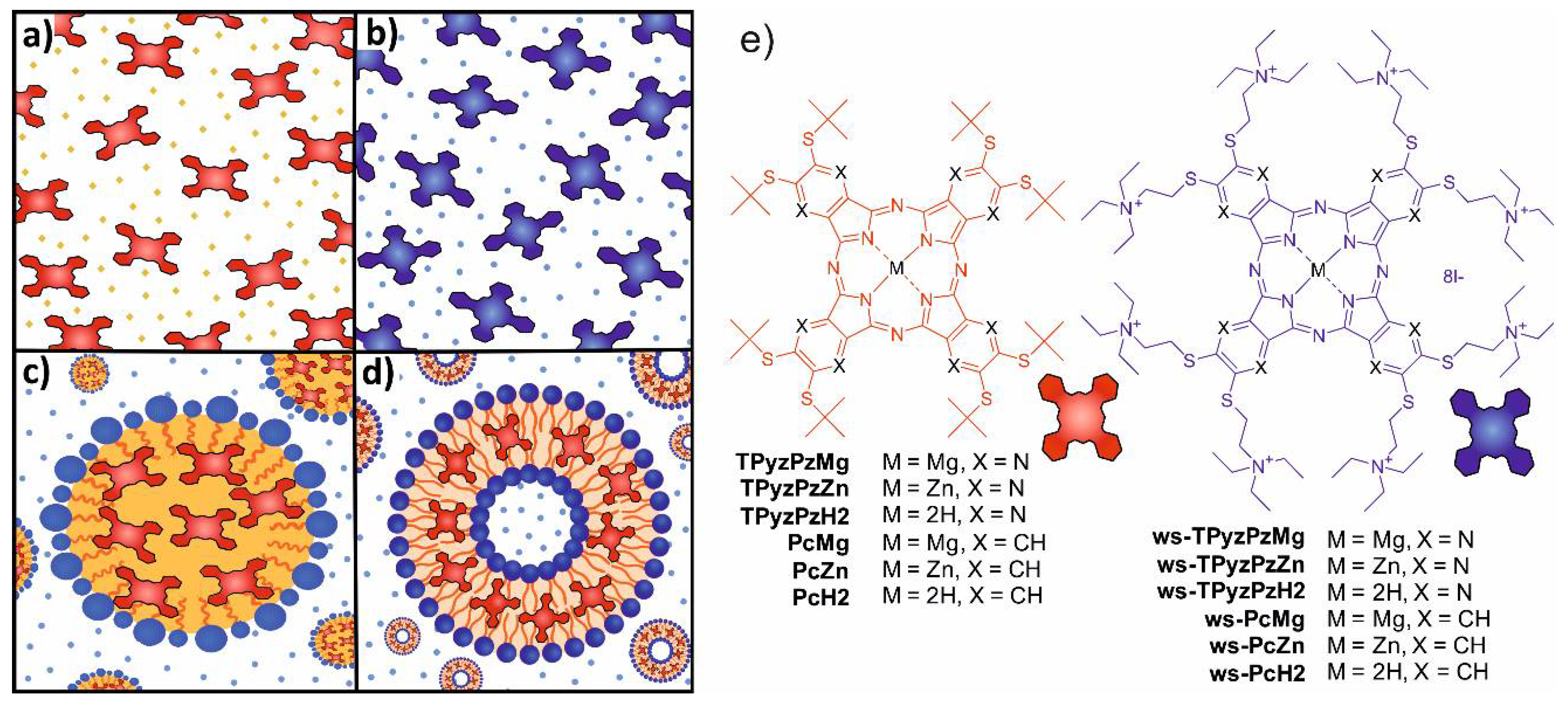

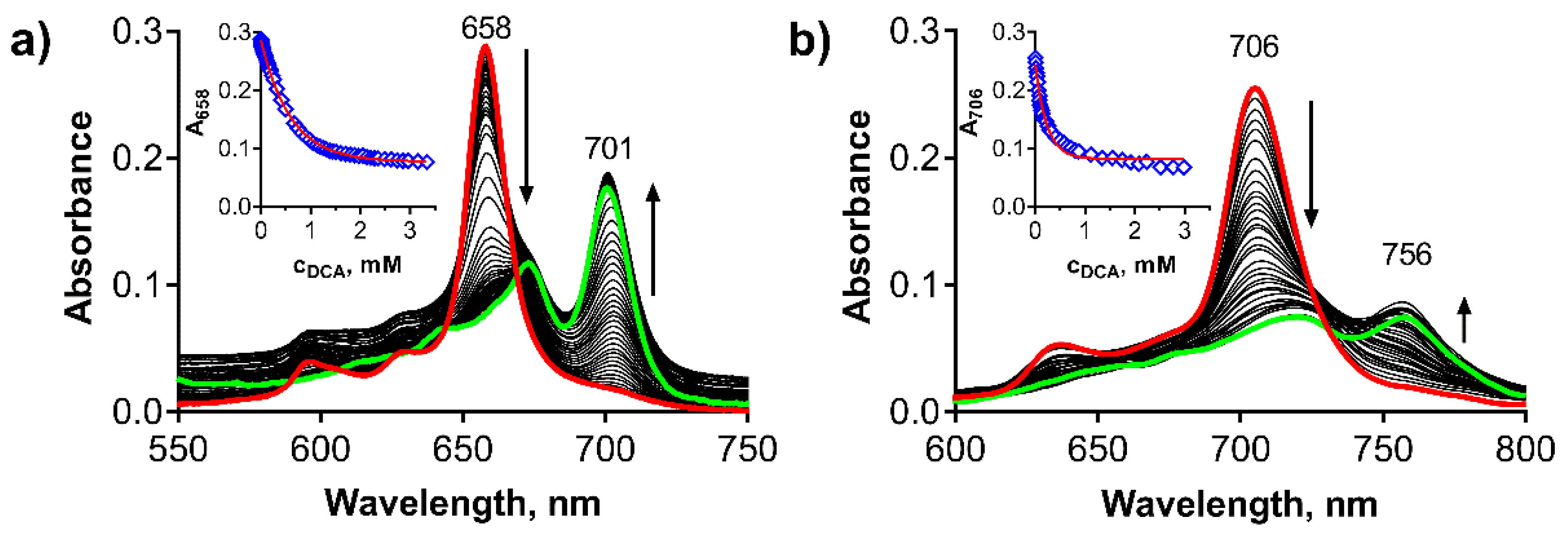

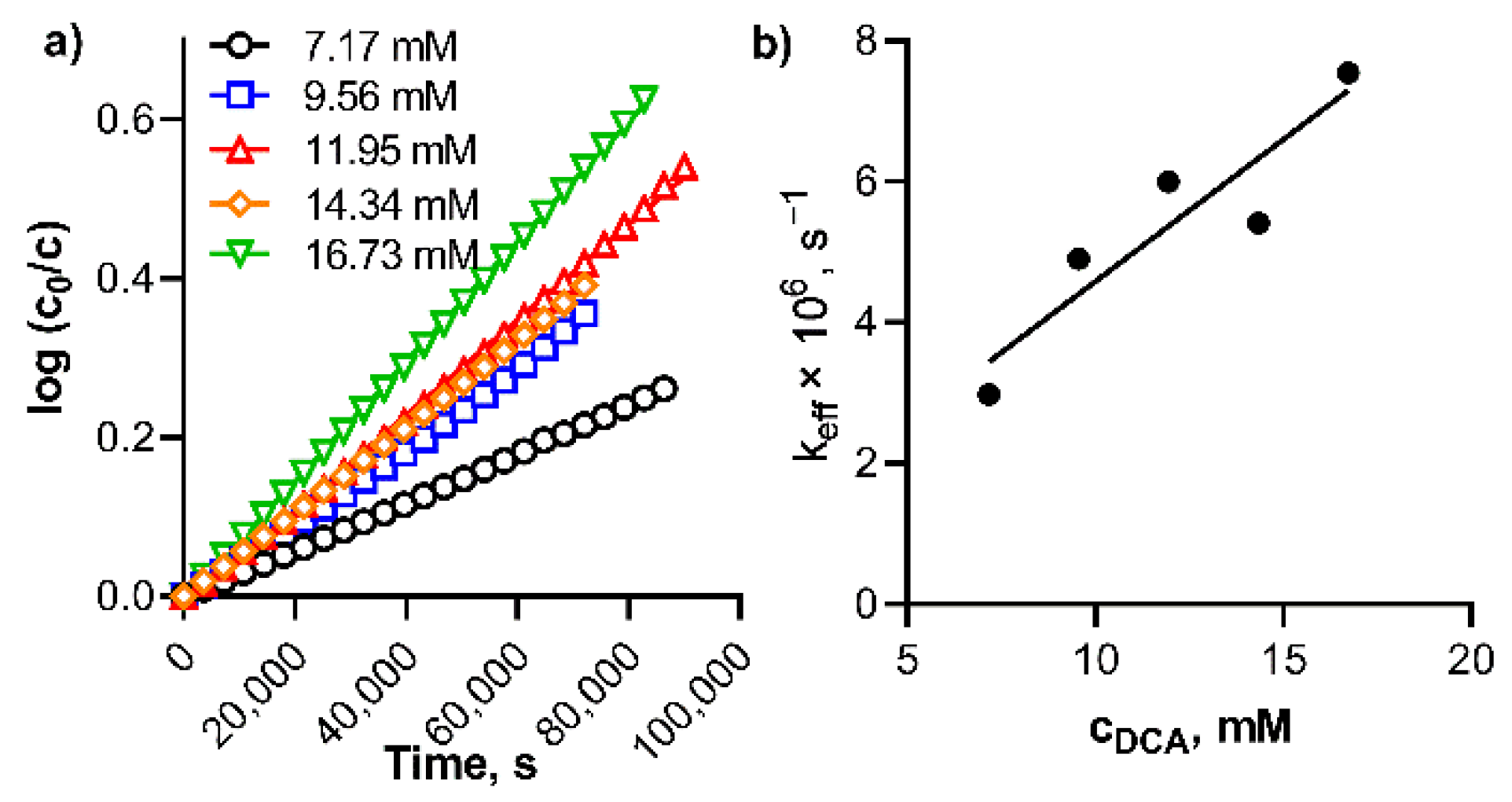
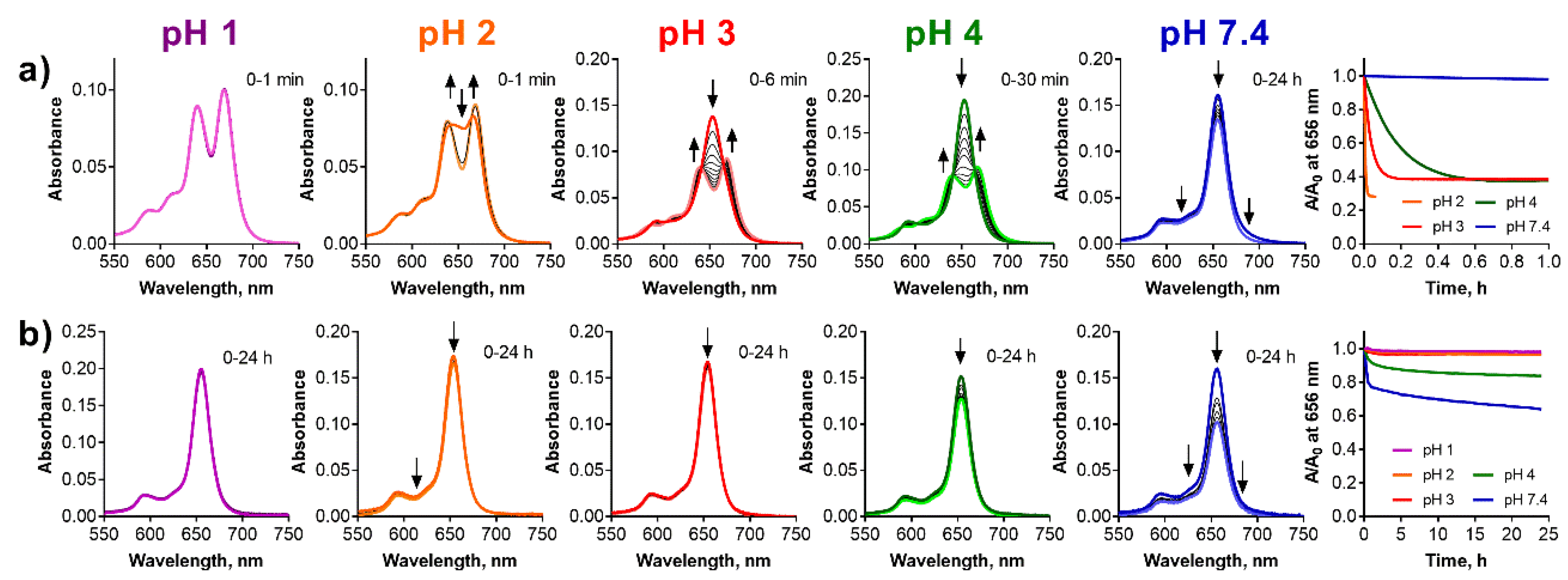
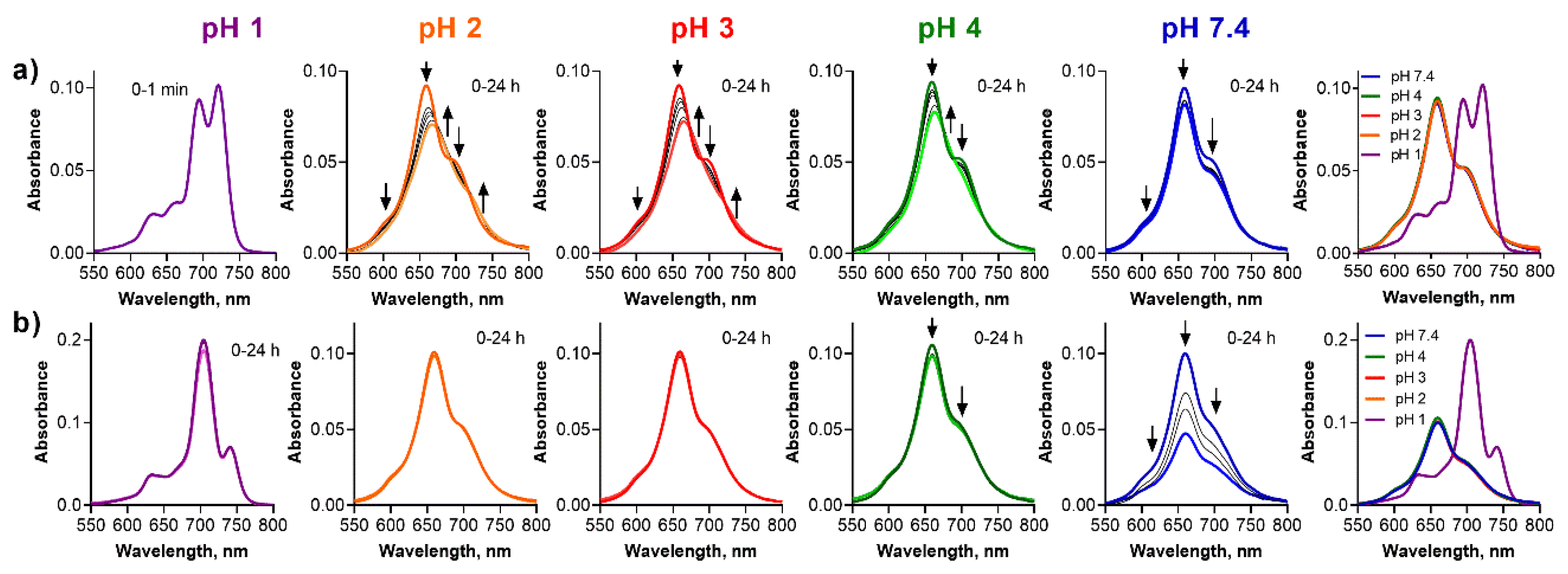
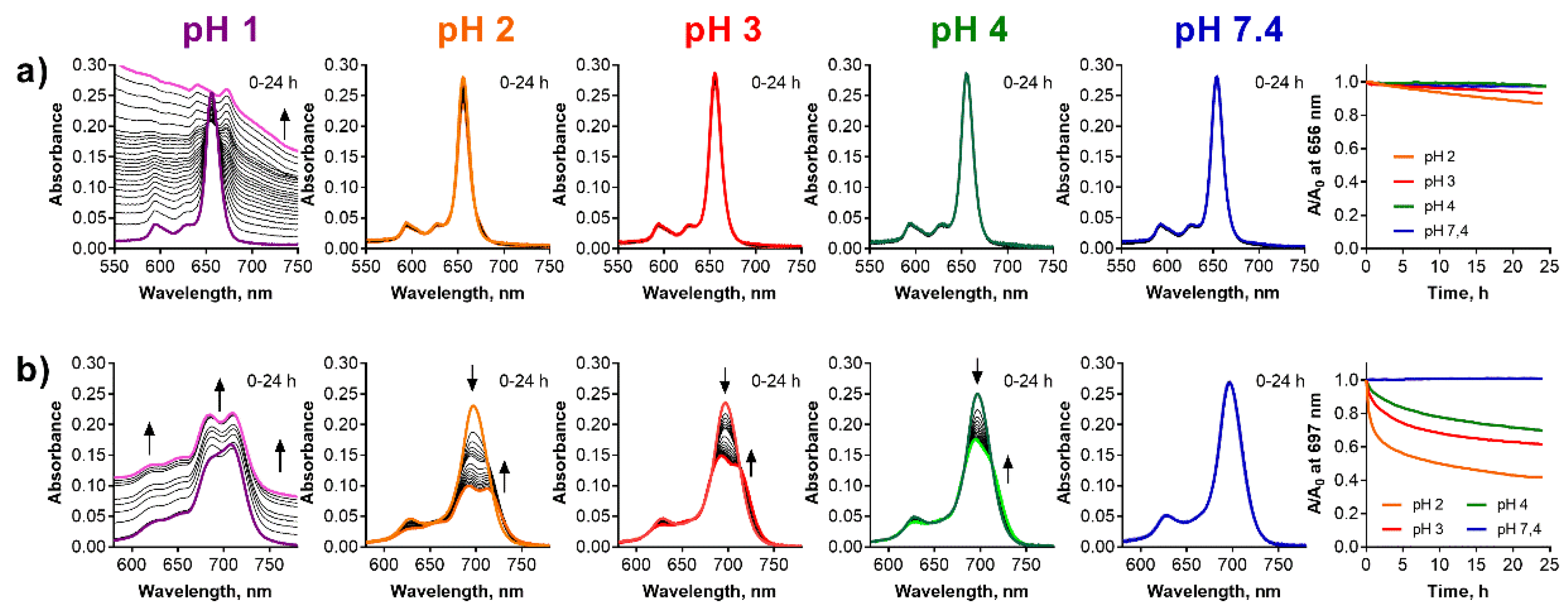

Publisher’s Note: MDPI stays neutral with regard to jurisdictional claims in published maps and institutional affiliations. |
© 2022 by the authors. Licensee MDPI, Basel, Switzerland. This article is an open access article distributed under the terms and conditions of the Creative Commons Attribution (CC BY) license (https://creativecommons.org/licenses/by/4.0/).
Share and Cite
Kolarova, M.; Mulaku, A.; Miletin, M.; Novakova, V.; Zimcik, P. Magnesium Phthalocyanines and Tetrapyrazinoporphyrazines: The Influence of a Solvent and a Delivery System on a Dissociation of Central Metal in Acidic Media. Pharmaceuticals 2022, 15, 409. https://doi.org/10.3390/ph15040409
Kolarova M, Mulaku A, Miletin M, Novakova V, Zimcik P. Magnesium Phthalocyanines and Tetrapyrazinoporphyrazines: The Influence of a Solvent and a Delivery System on a Dissociation of Central Metal in Acidic Media. Pharmaceuticals. 2022; 15(4):409. https://doi.org/10.3390/ph15040409
Chicago/Turabian StyleKolarova, Michaela, Anita Mulaku, Miroslav Miletin, Veronika Novakova, and Petr Zimcik. 2022. "Magnesium Phthalocyanines and Tetrapyrazinoporphyrazines: The Influence of a Solvent and a Delivery System on a Dissociation of Central Metal in Acidic Media" Pharmaceuticals 15, no. 4: 409. https://doi.org/10.3390/ph15040409
APA StyleKolarova, M., Mulaku, A., Miletin, M., Novakova, V., & Zimcik, P. (2022). Magnesium Phthalocyanines and Tetrapyrazinoporphyrazines: The Influence of a Solvent and a Delivery System on a Dissociation of Central Metal in Acidic Media. Pharmaceuticals, 15(4), 409. https://doi.org/10.3390/ph15040409





